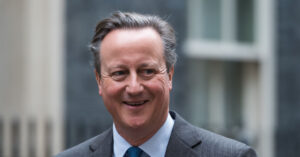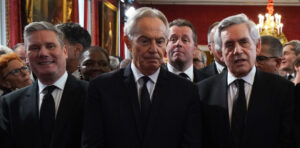In 1981, Neil Kinnock was attacked in the toilets at the Labour Party Conference. His assailant was a supporter of Tony Benn, eager to strike a blow for the radical Left; but as so often in the history of that tradition, he had underestimated the forces ranged against him. Kinnock, in his own words, “beat the shit out of him”, leaving “blood and vomit all over the place”. The same might have been said of the conference floor, where Benn and Denis Healey were bringing a seven-month struggle for the deputy leadership to a bitter end.
The chances are that Rishi Sunak won’t end up trading punches in the toilets with hostile MPs, but the atmosphere in the Conservative Party is taking on a familiar hue. Where once Labour was a byword for factionalism — with a dizzying array of Bennites, Tribunites and other “tendencies” — so the Tories today present a kaleidoscope of “New Conservatives”, “National Conservatives”, “Common Sense” Conservatives and self-styled “research groups”, all battling for control of the leadership. And where once a Social Democratic Party fought to “break the mould” of British politics, today the Right-wing Reform party proclaims a “realignment” intended to sweep the Conservatives from the electoral landscape. Over all this hangs the stench of electoral death, as the party contemplates defeat on the scale of 1983 or 1997.
But the Conservatives can still learn from Labour’s agonies in the Eighties. Then, Labour faced three interlocking crises. The first was electoral: from 1979 to 1992, Labour lost four general elections in a row — something that had never happened before in the democratic era. The fear was not simply that Labour was losing, but that its traditional electorate was disappearing. Deindustrialisation was shrinking the manual working class, trade-union membership was in freefall, while non-unionised workers seemed increasingly drawn to Thatcherism. The challenge for Labour was both to reclaim its old electorate and to build a new one, at a time of disruptive sociological change.
The second crisis was political, with the formation of a breakaway party by former Labour grandees. In David Owen, Shirley Williams, Bill Rodgers and Roy Jenkins, the SDP could boast the youngest foreign secretary in history, one of the most popular female politicians in the country, a skilled party organiser, and a former Chancellor, Home Secretary and President of the European Commission. Even under the pressures of First Past the Post, the SDP-Liberal Alliance won more than a quarter of the vote in 1983, coming only 2% behind Labour. In his first term, at least, the challenge for Kinnock was not to defeat the Conservatives. It was to stave off the threat from the Alliance.
The third problem was intellectual. Parties do not often rethink their core principles, but the questions being asked of Labour during this period were genuinely existential. Was socialism still relevant, in a world where workers were buying their own homes and filling them with consumer goods? Could one talk meaningfully about “working-class solidarity” when the long-term unemployed were so distanced from those in work? Was parliamentary socialism still possible, given the cultural and media power of the Right, or did industrial action pose a surer route to victory? From the hard-Left to the old-Right, there was universal agreement that Labour must change. What was so disruptive was the direction of change, and the principles on which it should be based.
For the Conservative Party today, the challenges are slightly different. Unlike Labour, modern Conservatives are accustomed to winning elections, but that makes the prospect of defeat all the more terrifying. Three-quarters of the parliamentary party, including all but six of the Cabinet, have no experience of opposition, yet the party has now trailed in the polls for more than two years. Those voters who remain loyal are heavily concentrated among the elderly. Labour leads in every cohort below the age of 65; and even the next oldest cohort, from 55-64, has the Conservatives at just 20%.
As for party competition, Reform cannot match the polling figures of the early Alliance, which peaked at more than 40%. Nor has it drawn heavyweight defections of the stature of Jenkins, Owen or Williams. But if Nigel Farage were to return to the leadership, it would boast a consummate campaigner with strong support among Conservative voters: Farage now polls more strongly among 2019 Conservatives than the current prime minister.
Underpinning both these problems is an intellectual dilemma. What is the Conservative Party for? And what, if anything, does it seek to conserve? Under First Past the Post, parties have to construct broad coalitions to be electorally competitive. At its best, that is a source of strength, expanding the range of ideas on which a party can draw and bringing different interests into partnership. At its worst, it generates unstable compounds that can explode at any moment. While Labour struggles to hold together Fabians, Left liberals, ethical socialists, trade unionists and social democrats, those jostling within the Conservative coalition have ranged from free traders to protectionists, libertarians to moral conservatives, Atlanticists to Empire loyalists, and institutionalists to radical populists. The surprise, perhaps, is not that such fissile materials sometimes combust, but that they do not do so more often.
For most of the 20th century, Conservatives could rely on two gravitational forces to keep their centrifugal tendencies in check. The first was a shared hostility to socialism. At a time when the Cold War dominated political alignment, fear of a common enemy was a potent unifying force. The party was also anchored in a set of common institutions: the Church of England, the professions and the institutions of the party itself, which boasted more than two million members at its peak. It was no accident that the party lost coherence after the fall of the Berlin Wall, as its own institutions shrivelled, and as it became either detached from or hostile to the institutions of state and civil society. The effect was to leave the party both socially and intellectually unmoored.
More recently, in 2019, the party could deploy two unifying forces: the desire to “Get Brexit Done”; and a determination to keep Jeremy Corbyn out of office. Neither exerts much power today. Britain has left the EU, and Labour is almost neurotically averse to reopening the question. Those Brexit questions which remain live are as likely to divide Conservatives as to unite them: notably, the status of retained EU law; the future of immigration policy; and the Northern Ireland border. As for Corbyn, he is no longer even a Labour MP. The current Labour leadership defines itself as much against Corbyn as against the Conservatives, and attempts to present Keir Starmer as a secret revolutionary have gained little traction with the public.
As its unifying elements weaken, other forces are driving the party apart. A tradition that once prided itself on its suspicion of “ideology” increasingly demands “true Conservatism” from its leaders, while disagreeing furiously on what that might be. Loyal newspapers that once catered to millions have become more sectarian as their readerships have shrunk, while new TV stations offer rich rewards for rebels and mavericks. The moderate, pragmatic MP who votes loyally with her party is unlikely to follow Nadine Dorries, Jacob Rees-Mogg, Lee Anderson and Esther McVey into the presenter’s chair at GB News or Talk TV.
All this puts a premium on skilled party management, yet there is little in Sunak’s past that has prepared him for this task. Jim Callaghan, who led a government with no majority at all for two years, had spent 30 years in Parliament, including 20 years on Labour’s national executive and a period as party chair. He had held four great offices of state and began his career as a trade-union official. By contrast, Sunak only entered Parliament in 2015, spent his short ministerial career at the Treasury and previously worked at a hedge fund. In a party that has disposed of four prime ministers in six years, even a majority of 60 has strained his powers of party management. Nor have the party’s strategists served him well, for the fashion for seeking “wedge issues” and “dividing lines” has inflamed divisions within the party, rather than establishing clear blue water with the opposition.
Yet as Labour’s experience demonstrates, division need not be terminal; and the Conservatives enjoy a number of structural advantages that were denied to Labour in the Eighties. That includes a largely sympathetic press and a donor base that can outspend their opponents even at the nadir of the party’s fortunes. The Right is in the ascendant across much of the West, and may soon take back the presidency of the United States. And in an age of short political careers, the Tory factions have no equivalent to Benn, Jenkins or Healey — household names with careers stretching back decades. The heavens do not tremble at the thunder of Sir Simon Clarke; nor do the mountains smoke at the voice of Robert Jenrick. That makes the party’s factions more volatile, but also less deeply entrenched.
Moreover, for a party accustomed to government, opposition may also have a galvanising effect. A Labour government would confront a grim inheritance: a public sector on fire, a financial crisis in local government, a stagnant economy and a perilous international situation — perhaps made more difficult by the return of Donald Trump. If there are good elections for the Conservatives to lose, 2024 may be one of them.
But if the party wishes to restore its intellectual vitality, it will need to face some uncomfortable truths. If the tax bill has risen under five Conservative leaders drawn from across the party spectrum, that is not because they lacked conviction or were secret socialists. A party that wishes to cut taxation must wrestle honestly with the dilemmas of an ageing population, a stagnant economy, a surging bill for social care and pensions, and growing pressure on the defence budget. If younger voters are abandoning the Conservative Party, that is not because they have been brainwashed by their teachers or indoctrinated on TikTok. It is because Conservatism has offered them little but mockery at a time of decaying wages and an impossible housing market.
As the once-great Liberal Party could affirm, parties do not have a divine right to survive. Those that cannot contain their divisions, that look inwards rather than out, and that blame the electorate for their own misfortunes are rarely rewarded at the polls. Like Labour in 1979, the Conservatives may soon be out of office. Unless they learn the lessons of the Eighties, it could be some time before they return.
Disclaimer
Some of the posts we share are controversial and we do not necessarily agree with them in the whole extend. Sometimes we agree with the content or part of it but we do not agree with the narration or language. Nevertheless we find them somehow interesting, valuable and/or informative or we share them, because we strongly believe in freedom of speech, free press and journalism. We strongly encourage you to have a critical approach to all the content, do your own research and analysis to build your own opinion.
We would be glad to have your feedback.
Source: UnHerd Read the original article here: https://unherd.com/




